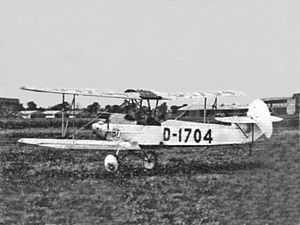Albatros L 82
The Albatros L 82 was a 1920s German trainer biplane. Of conventional configuration, it seated the pilot and instructor in separate, open cockpits. The wings were single-bay, equal-span, and unstaggered.
Operational history
The prototype and one production L 82b took part in the Challenge 1929 international contest, during which the prototype (D-1704) crashed on 10 August 1929 in Turnu Severin, pilot Karl Ziegler. The second example (D-1706) completed the contest in 27th place, pilot Werner Junck).[1]
Variants
Specifications (L 82c)
General characteristics
- Crew: two, pilot and instructor
- Length: 7.41 m (24 ft 4 in)
- Wingspan: 9.00 m (29 ft 6 in)
- Height: 2.66 m (8 ft 9 in)
- Wing area: 20.0 m2 (215 ft2)
- Empty weight: 400 kg (880 lb)
- Gross weight: 750 kg (1,650 lb)
- Powerplant: 1 × Siemens-Halske Sh 14, 120 kW (160 hp)
Performance
- Maximum speed: 160 km/h (100 mph)
- Range: 560 km (350 miles)
- Service ceiling: 3,800 m (12,500 ft)
See also
Notes
- ↑ Marian Krzyżan: Międzynarodowe turnieje lotnicze 1929-1934, Warsaw 1988
Bibliography
- Taylor, Michael J. H. (1989). Jane's Encyclopedia of Aviation. London: Studio Editions. p. 56.
External links
|
|---|
| | Pre World War I aircraft | |
|---|
| German military aircraft
of World War I | |
|---|
| Post wartype
company designations |
- L.3
- L.9
- L.58
- L.59
- L.60
- L.65
- L.66
- L.67
- L.68
- L.69
- L.70
- L.71
- L.72
- L.72A
- L.73
- L.74
- L.75
- L.76
- L.77
- L.78
- L.79
- L.81
- L.82
- L.83
- L.84
- L.101
- L.102
- L.103
|
|---|
|
|
|---|
| | General | |
|---|
| | Military | |
|---|
| | Accidents / incidents | |
|---|
| | Records | |
|---|
| | Misc. | |
|---|
|
